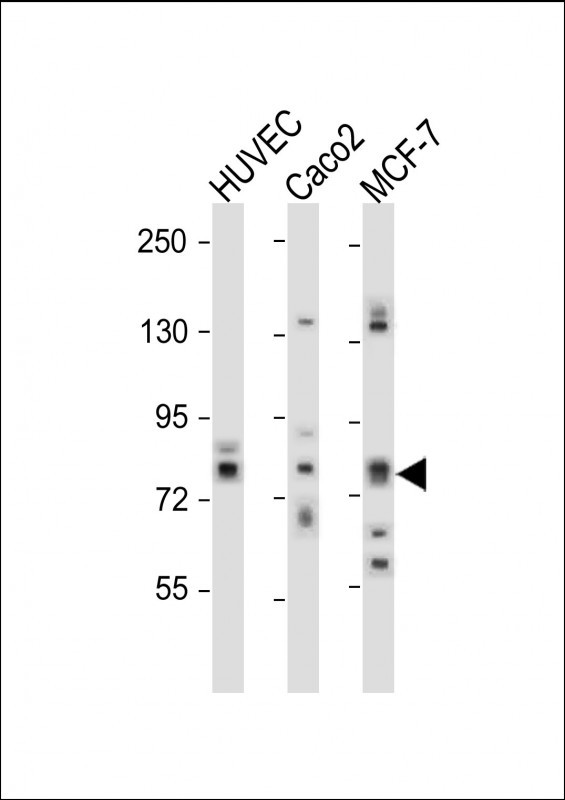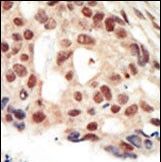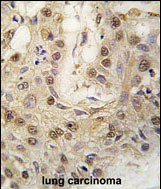cGKII Antibody (C-term)
Purified Rabbit Polyclonal Antibody (Pab)
- SPECIFICATION
- CITATIONS: 8
- PROTOCOLS
- BACKGROUND

Application
| WB, IHC-P, E |
|---|---|
| Primary Accession | Q13237 |
| Reactivity | Human |
| Host | Rabbit |
| Clonality | Polyclonal |
| Isotype | Rabbit IgG |
| Calculated MW | 87432 Da |
| Antigen Region | 714-744 aa |
| Gene ID | 5593 |
|---|---|
| Other Names | cGMP-dependent protein kinase 2, cGK 2, cGK2, cGMP-dependent protein kinase II, cGKII, PRKG2, PRKGR2 |
| Target/Specificity | This cGKII antibody is generated from rabbits immunized with a KLH conjugated synthetic peptide between 714-744 amino acids from the C-terminal region of human cGKII. |
| Dilution | WB~~1:1000 IHC-P~~1:50~100 E~~Use at an assay dependent concentration. |
| Format | Purified polyclonal antibody supplied in PBS with 0.09% (W/V) sodium azide. This antibody is purified through a protein A column, followed by peptide affinity purification. |
| Storage | Maintain refrigerated at 2-8°C for up to 2 weeks. For long term storage store at -20°C in small aliquots to prevent freeze-thaw cycles. |
| Precautions | cGKII Antibody (C-term) is for research use only and not for use in diagnostic or therapeutic procedures. |
| Name | PRKG2 |
|---|---|
| Synonyms | PRKGR2 |
| Function | Crucial regulator of intestinal secretion and bone growth. Phosphorylates and activates CFTR on the plasma membrane. Plays a key role in intestinal secretion by regulating cGMP-dependent translocation of CFTR in jejunum (PubMed:33106379). Acts downstream of NMDAR to activate the plasma membrane accumulation of GRIA1/GLUR1 in synapse and increase synaptic plasticity. Phosphorylates GRIA1/GLUR1 at Ser-863 (By similarity). Acts as a regulator of gene expression and activator of the extracellular signal-regulated kinases MAPK3/ERK1 and MAPK1/ERK2 in mechanically stimulated osteoblasts. Under fluid shear stress, mediates ERK activation and subsequent induction of FOS, FOSL1/FRA1, FOSL2/FRA2 and FOSB that play a key role in the osteoblast anabolic response to mechanical stimulation (By similarity). |
| Cellular Location | Apical cell membrane; Lipid-anchor |
| Tissue Location | Highly concentrated in brain, lung and intestinal mucosa |

Provided below are standard protocols that you may find useful for product applications.
Background
cGKII is thought to play a key role in a diverse set of physiological pathway. cGKII may mediate intestinal secretion of water and electrolytes induced by the E. coli toxin STa and the intestinal peptide guanylin. Edentification of the pathway that mediates intestinal fluid secretion by E. coli STa has potential medical implications because STa causes traveler's diarrhea and about 50% of infant mortality in developing countries. Transfection experiments in human cells disclose that cGKII phosphorylates SOX9 and attenuates SOX9 function by inhibiting its nuclear entry. Impaired differentiation of cultured KMI chondrocytes can be restored by silencing Sox9 by RNA interference. cGKII is postulated to be a molecular switch that couples the cessation of proliferation and the start of hypertrophic chondrocyte differentiation through attenuating SOX9 function.
References
Vaandrager, A.B., et al., J. Biol. Chem. 278(31):28651-28658 (2003).
Gambaryan, S., et al., Biochem. Biophys. Res. Commun. 293(5):1438-1444 (2002).
Orstavik, S., et al., Biochem. Biophys. Res. Commun. 220(3):759-765 (1996).
Fujii, M., et al., FEBS Lett. 375(3):263-267 (1995).
If you have used an Abcepta product and would like to share how it has performed, please click on the "Submit Review" button and provide the requested information. Our staff will examine and post your review and contact you if needed.
If you have any additional inquiries please email technical services at tech@abcepta.com.














 Foundational characteristics of cancer include proliferation, angiogenesis, migration, evasion of apoptosis, and cellular immortality. Find key markers for these cellular processes and antibodies to detect them.
Foundational characteristics of cancer include proliferation, angiogenesis, migration, evasion of apoptosis, and cellular immortality. Find key markers for these cellular processes and antibodies to detect them. The SUMOplot™ Analysis Program predicts and scores sumoylation sites in your protein. SUMOylation is a post-translational modification involved in various cellular processes, such as nuclear-cytosolic transport, transcriptional regulation, apoptosis, protein stability, response to stress, and progression through the cell cycle.
The SUMOplot™ Analysis Program predicts and scores sumoylation sites in your protein. SUMOylation is a post-translational modification involved in various cellular processes, such as nuclear-cytosolic transport, transcriptional regulation, apoptosis, protein stability, response to stress, and progression through the cell cycle. The Autophagy Receptor Motif Plotter predicts and scores autophagy receptor binding sites in your protein. Identifying proteins connected to this pathway is critical to understanding the role of autophagy in physiological as well as pathological processes such as development, differentiation, neurodegenerative diseases, stress, infection, and cancer.
The Autophagy Receptor Motif Plotter predicts and scores autophagy receptor binding sites in your protein. Identifying proteins connected to this pathway is critical to understanding the role of autophagy in physiological as well as pathological processes such as development, differentiation, neurodegenerative diseases, stress, infection, and cancer.



